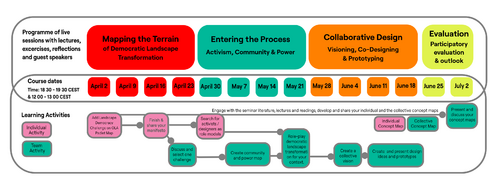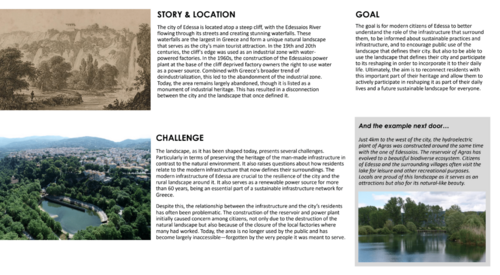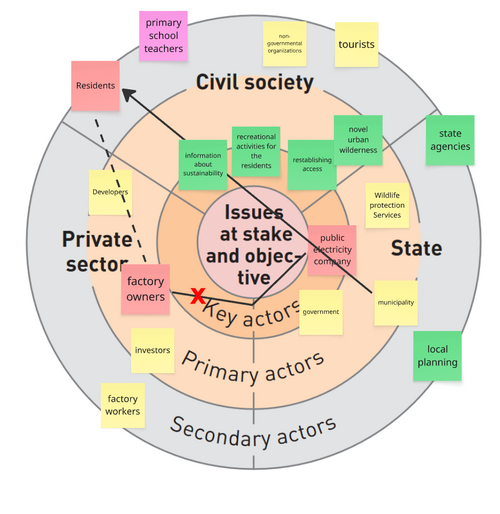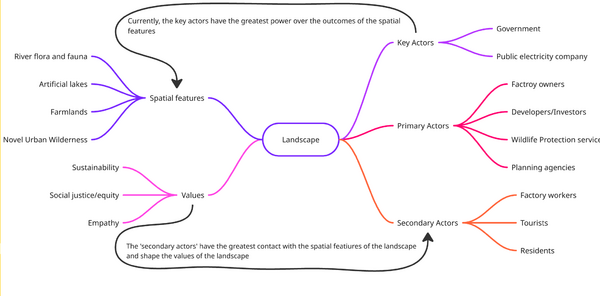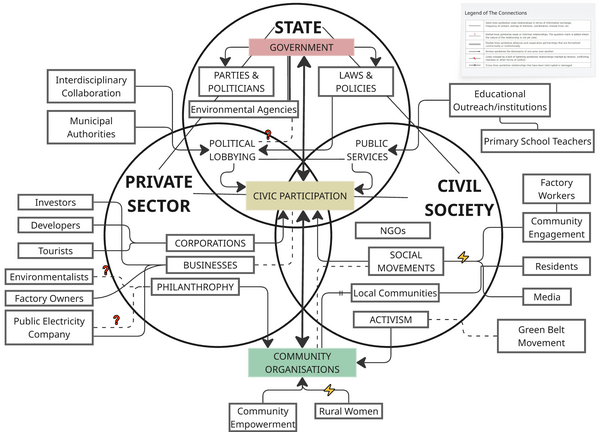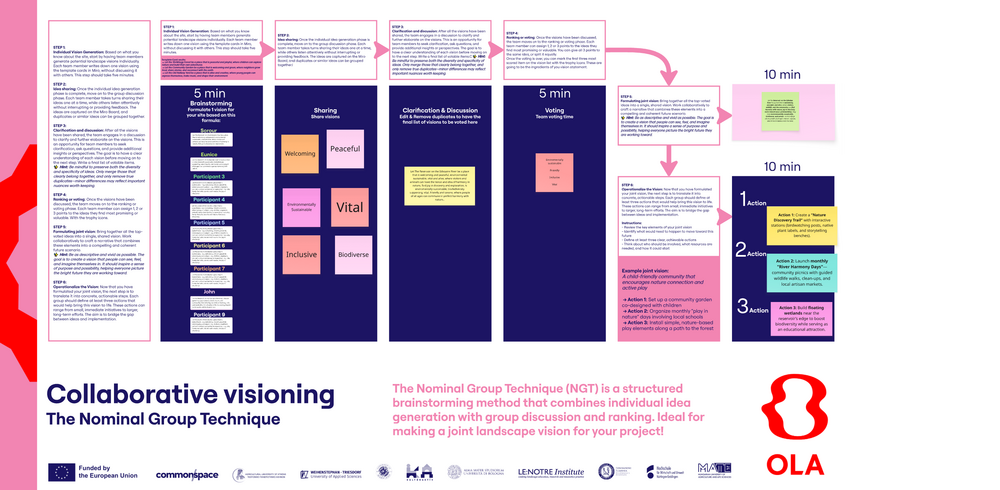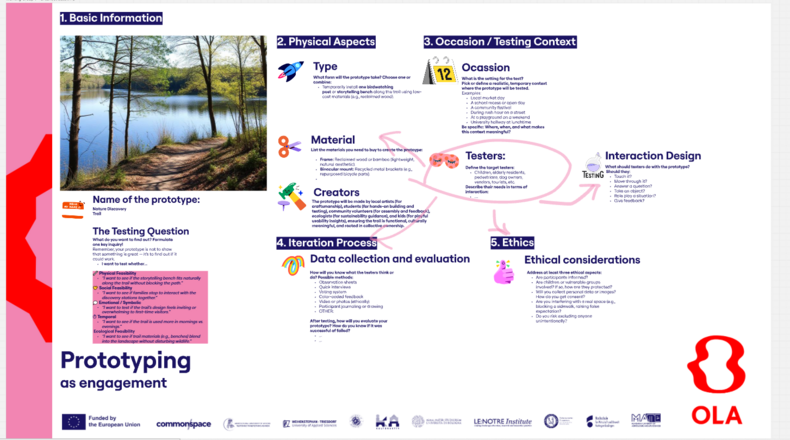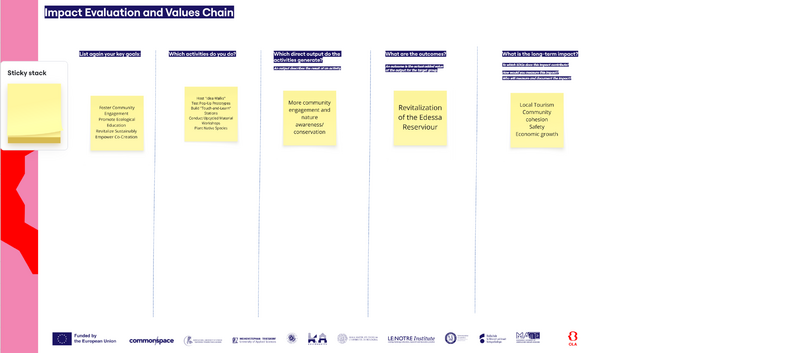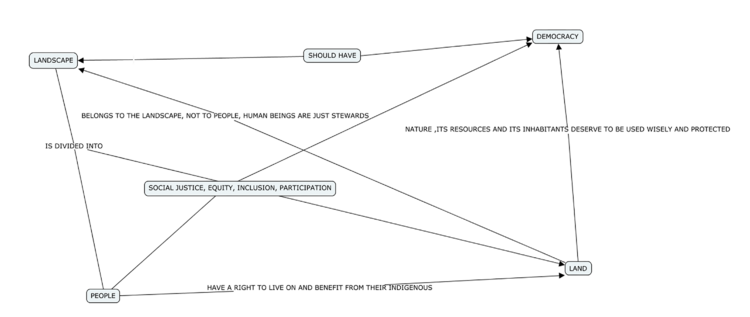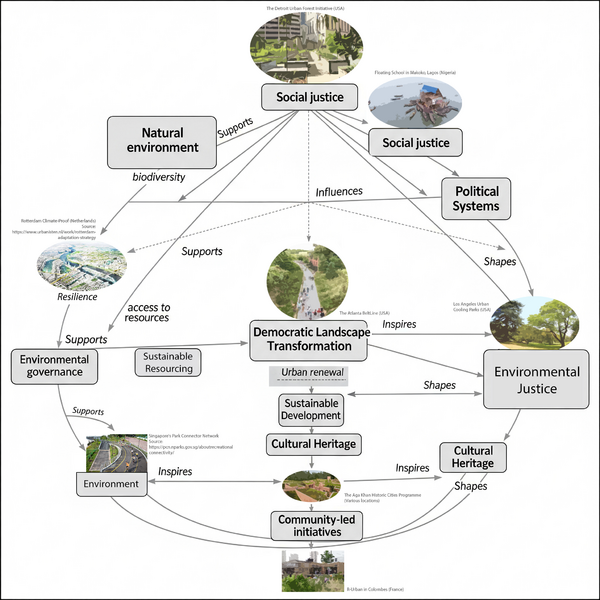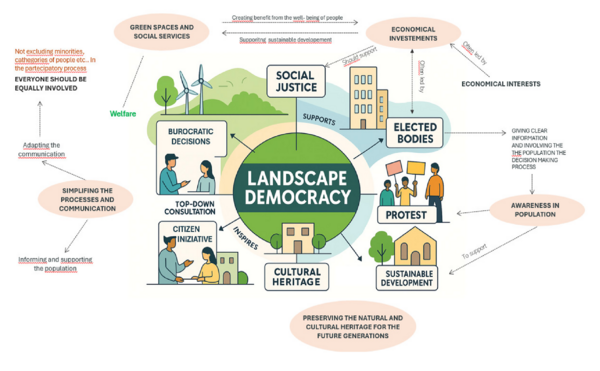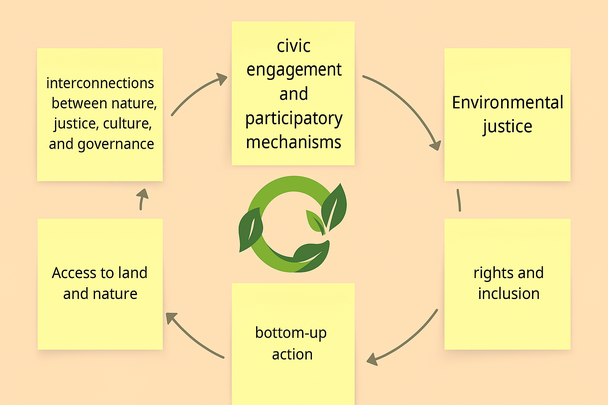Democratic Landscape Transformation 2025 - Team 1: Difference between revisions
| (49 intermediate revisions by 2 users not shown) | |||
| Line 1: | Line 1: | ||
'''>>> Back to [[Working_Groups_Democratic_Landscape_Transformation_2025|working group overview]]''' | '''>>> Back to [[Working_Groups_Democratic_Landscape_Transformation_2025|working group overview]]''' | ||
'''>>> Back to [[Resources_and_Literature_Landscape_and_Democracy|seminar reading list]]''' | '''>>> Back to [[Resources_and_Literature_Landscape_and_Democracy|seminar reading list, session materials & recordings]]''' | ||
'''>>> go to the [[Editing Help]] | '''>>> go to the [[Editing Help]] | ||
==Seminar process at a glance == | |||
[[File:Ola seminar programme overview 2025.png|500px|none|thumb|'''Seminar process:''' Click to enlarge. We meet weekly online at 18 pm CET on Wednesday from April 2 to July 2, an additional meeting opportunity is weekly from 12 00 - 13 00 pm CET]] | |||
==Background of your team== | ==Background of your team== | ||
''Please present your team briefly. Which linguistic and cultural perspectives does each member bring in? Which disciplinary backgrounds are present in your team? Note: if you prefer to stay anonymous on this wiki, you can also use initials only or a nick name'' | ''Please present your team briefly. Which linguistic and cultural perspectives does each member bring in? Which disciplinary backgrounds are present in your team? Note: if you prefer to stay anonymous on this wiki, you can also use initials only or a nick name'' | ||
* | *'''Sorour Ajili''', I have studied Bachelor of Architectural Engineering and Master of Interior Architecture, and I am currently studying Master of Engineering of Landscape Architecture at HfWU. My background combines technical and aesthetic architectural design, sustainable practices, and built environment. | ||
* | *'''Eunice Maina''', My Bachelor is in Urban and Regional Planning. I am currently undertaking an exchange program at HfWU doing Master of International Landscape Architecture. I am passionate about Sustainable Development and Governance. I am driven by the need to effect change by creating awareness and providing solutions that foster social equity. | ||
* | *'''Efstathios Chliaoutakis''', I have studied and got my master in Architectural Engineering at the National Technical University of Athens. Currently I study Landscape Architecture at Agricultural University of Athens. I am working as a freelance architect and part of interdisciplinary teams in projects of various scales. | ||
*team member, xxx | *team member, xxx | ||
*team member, xxx | *team member, xxx | ||
*team member, xxx | *team member, xxx | ||
==Your Landscape Democracy Manifestoes== | ==Your Landscape Democracy Manifestoes (Phase A) == | ||
''Here you can add here the links to the manifestoes you have presented on April 23. Please make sure that the links are accessible. You can also add them directly here on the wiki, they need to be png or jpg format then.'' | ''Here you can add here the links to the manifestoes you have presented on April 23. Please make sure that the links are accessible. You can also add them directly here on the wiki, they need to be png or jpg format then.'' | ||
* | *'''Sorour Ajili''', [https://drive.google.com/file/d/1xd_97Sz5NQqjCAAWr-PMZbJgvSM4IlqT/view?usp=sharing A Landscape of Conflict, Memory & Possibility] | ||
*'''Eunice Maina,''' [https://drive.google.com/file/d/1KsWiju3jXGL7xryEKR1bs0zkU464oTxe/view?usp=sharing Restoring Balance : Embracing Landscape Democracy for the Maasai] | |||
*'''Efstathios Chliaoutakis''', [https://www.dropbox.com/scl/fi/6ya5whzx6miy6hgjn6cuv/CHLIAOUTAKIS-MANIFESTO.pdf?rlkey=dt6g0bi7jypukrizz7td7yuqb&st=2ttpa8i5&dl=0 Arificial Infrastructure Landscapes in Edessa, Greece] | |||
*team member, xxx | *team member, xxx | ||
*team member, xxx | *team member, xxx | ||
*team member, xxx | *team member, xxx<br /> | ||
==Entering the Process: Activism, Community and Power (Phase B)== | |||
===Global Landscape Democracy Role Models and Design Activism=== | |||
== Entering the Process: Activism, Community and Power == | |||
=== Global Landscape Democracy Role Models and Design Activism=== | |||
At the beginning of phase B we ask you to identify people who are already active for democratic landscape transformation. These can be planners and designers, NGOs, collectives or activists, or people operating creatively at the interface of these categories. 'Design activism' is a possible overarching category. We created [[Resources_and_Literature_Landscape_and_Democracy#Short_List_of_Landscape_Democracy_'Movers_and_Shakers'_(to_be_extended)|a list]] some time ago, but it has a very US/European focus, due to the history of our project. We really want to expand this and hope you can bring in new people and movements from around the globe. | At the beginning of phase B we ask you to identify people who are already active for democratic landscape transformation. These can be planners and designers, NGOs, collectives or activists, or people operating creatively at the interface of these categories. 'Design activism' is a possible overarching category. We created [[Resources_and_Literature_Landscape_and_Democracy#Short_List_of_Landscape_Democracy_'Movers_and_Shakers'_(to_be_extended)|a list]] some time ago, but it has a very US/European focus, due to the history of our project. We really want to expand this and hope you can bring in new people and movements from around the globe. | ||
On May 14, every team member introduces a landscape democracy activist/or design activist individual or group. Please add the people you introduced, you may also add the presentation material used with a downloadable link: | On May 14, every team member introduces a landscape democracy activist/or design activist individual or group. Please add the people you introduced, you may also add the presentation material used with a downloadable link: | ||
* | *'''Sorour Ajili''', [https://www.scapestudio.com/people/ Kate Orff, ''"landscape architecture to address global challenges of climate change and social and'' ''environmental justice."''] | ||
* | *Eunice Maina, [https://www.lse.ac.uk/africa/hub-for-african-thought/thinkers/Wangari-Maathai#:~:text=Activism,Kenya%20from%201978%20to%202002. Wangari Maathai] | ||
*'''Efstathios Chliaoutakis''', [https://www.facebook.com/profile.php?id=61567196014969&mibextid=LQQJ4d&rdid=Ykx5jIZBrvMaPAY5&share_url=https%3A%2F%2Fwww.facebook.com%2Fshare%2FYwywh2kQbQBnKmjq%2F%3Fmibextid%3DLQQJ4d# Solidarity Colors] | |||
* | [[File:Miro Page, Activists.png|thumb|547x547px|Miro board clip, Our Activists|none]] | ||
== Your Team's Landscape Democracy Challenge (Phase B) == | == Your Team's Landscape Democracy Challenge (Phase B)== | ||
* Due: May 21 | *Due: May 21 | ||
=== Context and Location === | ===Context and Location=== | ||
'' | ''The relationship between the infrastructure of Edessa, Greece and the city residents has often been problematic. The construction of a reservoir and power plant initially caused concern among citizens, not only due to the destruction of the natural landscape but also because of the closure of the local factories where many had worked. Today, the area is no longer used by the public and has become largely inaccessible—forgotten by the very people it was meant to serve.'' | ||
[[File:Efstathios Manifesto .png|thumb|500x500px|'''Efstathios' Manifesto''' |none]] | |||
[[File:Identified actors on the grid.png|none|thumb|514x514px|'''Identified actors on the grid''']] | |||
=== Landscape and Community Map === | ===Landscape and Community Map=== | ||
''Present here a visual representation of the landscape and community context of the area. What are the main spatial features? Which actors can you identify and how are they related to the area? Which values exist and for whom? What is at risk and why? Try to generate creative/conceptual/synthetic representation'' | ''Present here a visual representation of the landscape and community context of the area. What are the main spatial features? Which actors can you identify and how are they related to the area? Which values exist and for whom? What is at risk and why? Try to generate creative/conceptual/synthetic representation'' | ||
[[File:Community Map Gr 1.png|thumb|600x600px|'''Landscape/Community Map According To Our Landscape Democracy Design Activists'''|none]] | |||
=== Power Map === | ===Power Map=== | ||
''Based on the landscape and community context depicted above: How is power distributed? Who and what has a lot of power? Who and what has no power? Who and what is strongly affected by the landscape democracy challenges? Who and what is less affected? Are these actors connected or disconnected? Any veto-players known? Try to generate creative/conceptual/synthetic representation'' | ''Based on the landscape and community context depicted above: How is power distributed? Who and what has a lot of power? Who and what has no power? Who and what is strongly affected by the landscape democracy challenges? Who and what is less affected? Are these actors connected or disconnected? Any veto-players known? Try to generate creative/conceptual/synthetic representation'' | ||
'''You can present your results in this gallery:''' | '''You can present your results in this gallery:''' | ||
<gallery | <gallery widths="500" heights="200" perrow="1" caption="[[File:Power Map-group 1.png|thumb|600x600px|Power Map According To Our Landscape Democracy Design Activists|none]]"> | ||
File: | |||
</gallery> | </gallery> | ||
== Your Team's Landscape Democracy Vision and Ideas (Phase C) == | ==Your Team's Landscape Democracy Vision and Ideas (Phase C)== | ||
* Due: June 18 | *Due: June 18 | ||
=== Collective Vision === | ===Collective Vision=== | ||
'' | ''Let the '''Reservoir on the Edissian River''' be a place that is '''welcoming, peaceful, and alive''', where '''visitors, wildlife, and the community''' can '''find harmony with nature, joy in discovery, and a shared sense of stewardship'''. May it be '''environmentally sustainable, biodiverse, and serene'''—a vital refuge where people of all ages connect, explore, and thrive in balance with the land.'' | ||
[[File:Group 1 Collaborative Visioning.png|none|thumb|1000x1000px|'''Group 1 Collaborative Visioning''']] | |||
=== A prototype of the first step === | ===A prototype of the first step=== | ||
''How | |||
=== ''1. Entering the Process: Start Small, Start Fast'' === | |||
''Begin with a "Pop-Up Discovery Station" (one birdwatching post + one storytelling bench) as a low-cost, high-impact way to test the concept.'' | |||
''Why?'' | |||
* ''Minimal materials (reclaimed wood, borrowed binoculars).'' | |||
* ''Quick to install/uninstall.'' | |||
* ''Tests physical, social, and emotional feasibility all at once.'' | |||
---- | |||
=== ''2. Activating the Prototype'' === | |||
''How to Build It:'' | |||
* ''Birdwatching Post: Repurpose a wooden pole with a mounted pair of cheap binoculars and a laminated guide to 3–5 common local birds.'' | |||
* ''Storytelling Bench: Use a donated park bench + a QR code linking to a 2-minute audio story (recorded by a local elder or student).'' | |||
''Test Goals:'' | |||
* ''Do people stop to use it?'' | |||
* ''Do kids engage with the binoculars/audio?'' | |||
* ''Does it feel intrusive or welcoming?'' | |||
---- | |||
=== ''3. Introducing It to the Community'' === | |||
''Launch Tactics:'' | |||
* ''"Mystery Installation" Day:'' | |||
** ''Set up the station overnight with a playful sign: “Try me! Your feedback shapes Edessa’s new nature trail.”'' | |||
** ''Observe how people react organically.'' | |||
* ''Guided "Discovery Walk":'' | |||
** ''Invite 10–20 locals (families, teachers, NGOs) to test the station together.'' | |||
** ''Offer snacks and ask: “What would make you come back?”'' | |||
* ''Storytelling Hook:'' | |||
** ''Partner with a school to record short tales about the river, played at the bench. “Hear what the herons saw 50 years ago!”'' | |||
'''You can present your results in this gallery:''' | '''You can present your results in this gallery:''' | ||
[[File:Nature Discovery Trail.png|none|thumb|790x790px|'''The "Nature Discovery Trail" is an interactive outdoor pathway designed to engage visitors with the natural environment through hands-on learning and exploration.''' ]] | |||
[[File:Impact Evaluation and Values Chain.png|none|thumb|790x790px|'''Impact Evaluation and Values Chain''']] | |||
==Cross-cutting activity: Readings, concepts and definitions (Phases A - D)== | |||
== Cross-cutting activity: Readings, concepts and definitions == | |||
*Due: July 2, 2025 | *Due: July 2, 2025 | ||
| Line 82: | Line 115: | ||
The final product is a '''shared concept map''' that integrates the various understandings present within your team. | The final product is a '''shared concept map''' that integrates the various understandings present within your team. | ||
=== About concept mapping === | ===About concept mapping=== | ||
Before starting the exercise you can read this article by Joseph D. Novak & Alberto J. Cañas about [http://cmap.ihmc.us/Publications/ResearchPapers/TheoryCmaps/TheoryUnderlyingConceptMaps.htm Theory Underlying Concept Maps and How to Construct and Use Them]. This paper gives a good explanation of how concept maps are conceived and developed. | Before starting the exercise you can read this article by Joseph D. Novak & Alberto J. Cañas about [http://cmap.ihmc.us/Publications/ResearchPapers/TheoryCmaps/TheoryUnderlyingConceptMaps.htm Theory Underlying Concept Maps and How to Construct and Use Them]. This paper gives a good explanation of how concept maps are conceived and developed. | ||
You can use any tool you like for producing your concept map. However, since the result needs to be submitted digitally we recommend the following open source software for producing your maps: | You can use any tool you like for producing your concept map. However, since the result needs to be submitted digitally we recommend the following open source software for producing your maps: | ||
* [http://cmap.ihmc.us Cmap Tools] >>> you can also work with your group on the Cmap cloud doing a shared map | *[http://cmap.ihmc.us Cmap Tools] >>> you can also work with your group on the Cmap cloud doing a shared map | ||
* [http://vue.tufts.edu VUE - The Visual Understanding Environment] | *[http://vue.tufts.edu VUE - The Visual Understanding Environment] | ||
* Use a '''shared whiteboard''' to develop your integrated concept map, such as [http://miro.com/ MIRO] or [http://mural.co/ MURAL] | *Use a '''shared whiteboard''' to develop your integrated concept map, such as [http://miro.com/ MIRO] or [http://mural.co/ MURAL] | ||
=== How to present your concept maps === | ===How to present your concept maps=== | ||
* Possible format: JPG (for wiki upload) or link to any other resource | *Possible format: JPG (for wiki upload) or link to any other resource | ||
* We give you below a draft image gallery where you can add pictures of your map (in JPG or PNG format) | * We give you below a draft image gallery where you can add pictures of your map (in JPG or PNG format) | ||
* You can present your integrated understanding as one concept map '''or''' your present individual ones '''and''' the integrated one. | *You can present your integrated understanding as one concept map '''or''' your present individual ones '''and''' the integrated one. | ||
* add as many additional materials as you need | *add as many additional materials as you need | ||
===Overview of your concept maps ( | ===Overview of your concept maps (individual and integrated)=== | ||
<gallery widths=" | |||
File: | <gallery widths="600" heights="300" perrow="4" caption="[[File:Eunice Maina Concept Map .png|thumb|750x750px|Eunice Maina Individual Landscape Democracy Concept Map|none]][[File:Sorour Ajili Seminar Democratic Landscape Transformation Individual Concept Map Sorour Ajili.png|thumb|600x600px|Sorour Ajili Individual Landscape Democracy Concept Map|none]][[File:Aliessia Cantone Individual Concept Map.png|thumb|600x600px|Aliessia Cantone Individual Landscape Democracy Concept Map|none]]"> | ||
File: | </gallery>[[File:Group One Integrated Concept Map.png|thumb|608x608px|'''Group One Integrated Landscape Democracy Concept Map'''|none]] | ||
File: | ==Please finish with a short reflection (Phase D)== | ||
Due: July 9, 2025 | |||
*'''What are the similarities and differences in your team regarding your understanding of what democratic landscape transformation is?''' | |||
Together, we shared the belief that democratic landscape transformation is an inclusive and participatory process by which communities actively co-produce their spaces. Together, we emphasized '''civic engagement, environmental justice''', and '''rights and inclusion''' as core principles. | |||
Where our perspectives disagreed was on priority - | |||
*One of the team members focused on '''bottom-up action''', highlighting the power of grassroots participation and local empowerment. | |||
*Another saw prioritizing '''access to nature and land''', emphasizing fair sharing of resources and the removal of social and physical barriers. | |||
*A third prioritized '''participatory mechanisms and civic engagement''' as key to building trust and open government. These diverse responses reflect a collective vision of voice and justice in the community, although all convey different perspectives on where democratic change must begin, ranging from system reform to collective and personal action. | |||
* '''In how far did the seminar lectures and readings help you to clarify this?''' | |||
The seminar provided a solid basis for learning about democratic landscape transformation from multiple perspectives. Through diverse readings, case studies, and participative instruments, we were introduced to tangible ways of promoting more community-based and inclusive landscape development. Rather than being mired in theory, the course permitted us to cross conceptual bridges between concepts like '''equity''', '''co-authorship''', and '''governance''' and specific processes, shedding light on how landscapes both reflect physical design, but also cultural values, power dynamics, and collective memory. The experience improved our ability for critical examination and active participation in more equitable and resilient places. | |||
*'''What will you take home from this seminar?''' | |||
This seminar shifted the way we conceptualize landscapes, no longer as spatial arrangements, but as evolving systems shaped by social, ecological, and cultural relationships. We leave with a greater recognition that landscape transformation must be '''participatory, equity''', and sensitive to '''collective memory, identity,''' and '''rights of all'''. | |||
The major takeaways are: | |||
*The necessity of inclusive, open processes in environmental decision-making. | |||
* | *Grasping both ecosystems and humans as agents and having value in landscape shaping. | ||
* | *The potential of grassroots and local-scale action to influence greater levels of governance. | ||
* | *The interconnection of '''justice, resilience''', and '''community-based stewardship'''. | ||
[[Category:OLA Working Group | Essentially, the seminar provided us with real-world learning and thinking tools for advancing landscapes that are co-created, site-specific, and sensitive to social as well as environmental needs. | ||
[[Category:OLA Working Group 2025]] | |||
Latest revision as of 20:10, 9 July 2025
>>> Back to working group overview
>>> Back to seminar reading list, session materials & recordings
>>> go to the Editing Help
Seminar process at a glance
Background of your team
Please present your team briefly. Which linguistic and cultural perspectives does each member bring in? Which disciplinary backgrounds are present in your team? Note: if you prefer to stay anonymous on this wiki, you can also use initials only or a nick name
- Sorour Ajili, I have studied Bachelor of Architectural Engineering and Master of Interior Architecture, and I am currently studying Master of Engineering of Landscape Architecture at HfWU. My background combines technical and aesthetic architectural design, sustainable practices, and built environment.
- Eunice Maina, My Bachelor is in Urban and Regional Planning. I am currently undertaking an exchange program at HfWU doing Master of International Landscape Architecture. I am passionate about Sustainable Development and Governance. I am driven by the need to effect change by creating awareness and providing solutions that foster social equity.
- Efstathios Chliaoutakis, I have studied and got my master in Architectural Engineering at the National Technical University of Athens. Currently I study Landscape Architecture at Agricultural University of Athens. I am working as a freelance architect and part of interdisciplinary teams in projects of various scales.
- team member, xxx
- team member, xxx
- team member, xxx
Your Landscape Democracy Manifestoes (Phase A)
Here you can add here the links to the manifestoes you have presented on April 23. Please make sure that the links are accessible. You can also add them directly here on the wiki, they need to be png or jpg format then.
- Sorour Ajili, A Landscape of Conflict, Memory & Possibility
- Eunice Maina, Restoring Balance : Embracing Landscape Democracy for the Maasai
- Efstathios Chliaoutakis, Arificial Infrastructure Landscapes in Edessa, Greece
- team member, xxx
- team member, xxx
- team member, xxx
Entering the Process: Activism, Community and Power (Phase B)
Global Landscape Democracy Role Models and Design Activism
At the beginning of phase B we ask you to identify people who are already active for democratic landscape transformation. These can be planners and designers, NGOs, collectives or activists, or people operating creatively at the interface of these categories. 'Design activism' is a possible overarching category. We created a list some time ago, but it has a very US/European focus, due to the history of our project. We really want to expand this and hope you can bring in new people and movements from around the globe.
On May 14, every team member introduces a landscape democracy activist/or design activist individual or group. Please add the people you introduced, you may also add the presentation material used with a downloadable link:
- Sorour Ajili, Kate Orff, "landscape architecture to address global challenges of climate change and social and environmental justice."
- Eunice Maina, Wangari Maathai
- Efstathios Chliaoutakis, Solidarity Colors
Your Team's Landscape Democracy Challenge (Phase B)
- Due: May 21
Context and Location
The relationship between the infrastructure of Edessa, Greece and the city residents has often been problematic. The construction of a reservoir and power plant initially caused concern among citizens, not only due to the destruction of the natural landscape but also because of the closure of the local factories where many had worked. Today, the area is no longer used by the public and has become largely inaccessible—forgotten by the very people it was meant to serve.
Landscape and Community Map
Present here a visual representation of the landscape and community context of the area. What are the main spatial features? Which actors can you identify and how are they related to the area? Which values exist and for whom? What is at risk and why? Try to generate creative/conceptual/synthetic representation
Power Map
Based on the landscape and community context depicted above: How is power distributed? Who and what has a lot of power? Who and what has no power? Who and what is strongly affected by the landscape democracy challenges? Who and what is less affected? Are these actors connected or disconnected? Any veto-players known? Try to generate creative/conceptual/synthetic representation
You can present your results in this gallery:
Your Team's Landscape Democracy Vision and Ideas (Phase C)
- Due: June 18
Collective Vision
Let the Reservoir on the Edissian River be a place that is welcoming, peaceful, and alive, where visitors, wildlife, and the community can find harmony with nature, joy in discovery, and a shared sense of stewardship. May it be environmentally sustainable, biodiverse, and serene—a vital refuge where people of all ages connect, explore, and thrive in balance with the land.
A prototype of the first step
1. Entering the Process: Start Small, Start Fast
Begin with a "Pop-Up Discovery Station" (one birdwatching post + one storytelling bench) as a low-cost, high-impact way to test the concept.
Why?
- Minimal materials (reclaimed wood, borrowed binoculars).
- Quick to install/uninstall.
- Tests physical, social, and emotional feasibility all at once.
2. Activating the Prototype
How to Build It:
- Birdwatching Post: Repurpose a wooden pole with a mounted pair of cheap binoculars and a laminated guide to 3–5 common local birds.
- Storytelling Bench: Use a donated park bench + a QR code linking to a 2-minute audio story (recorded by a local elder or student).
Test Goals:
- Do people stop to use it?
- Do kids engage with the binoculars/audio?
- Does it feel intrusive or welcoming?
3. Introducing It to the Community
Launch Tactics:
- "Mystery Installation" Day:
- Set up the station overnight with a playful sign: “Try me! Your feedback shapes Edessa’s new nature trail.”
- Observe how people react organically.
- Guided "Discovery Walk":
- Invite 10–20 locals (families, teachers, NGOs) to test the station together.
- Offer snacks and ask: “What would make you come back?”
- Storytelling Hook:
- Partner with a school to record short tales about the river, played at the bench. “Hear what the herons saw 50 years ago!”
You can present your results in this gallery:
Cross-cutting activity: Readings, concepts and definitions (Phases A - D)
- Due: July 2, 2025
While working in your group, please start to express your personal understanding of the relation of landscape and democracy in the form of a concept map with linking words or any other diagrammatic representation. Please make your maps very visual and not just verbal. Think critically about why one map differs from another.
The final product is a shared concept map that integrates the various understandings present within your team.
About concept mapping
Before starting the exercise you can read this article by Joseph D. Novak & Alberto J. Cañas about Theory Underlying Concept Maps and How to Construct and Use Them. This paper gives a good explanation of how concept maps are conceived and developed.
You can use any tool you like for producing your concept map. However, since the result needs to be submitted digitally we recommend the following open source software for producing your maps:
- Cmap Tools >>> you can also work with your group on the Cmap cloud doing a shared map
- VUE - The Visual Understanding Environment
- Use a shared whiteboard to develop your integrated concept map, such as MIRO or MURAL
How to present your concept maps
- Possible format: JPG (for wiki upload) or link to any other resource
- We give you below a draft image gallery where you can add pictures of your map (in JPG or PNG format)
- You can present your integrated understanding as one concept map or your present individual ones and the integrated one.
- add as many additional materials as you need
Overview of your concept maps (individual and integrated)
Please finish with a short reflection (Phase D)
Due: July 9, 2025
- What are the similarities and differences in your team regarding your understanding of what democratic landscape transformation is?
Together, we shared the belief that democratic landscape transformation is an inclusive and participatory process by which communities actively co-produce their spaces. Together, we emphasized civic engagement, environmental justice, and rights and inclusion as core principles.
Where our perspectives disagreed was on priority -
- One of the team members focused on bottom-up action, highlighting the power of grassroots participation and local empowerment.
- Another saw prioritizing access to nature and land, emphasizing fair sharing of resources and the removal of social and physical barriers.
- A third prioritized participatory mechanisms and civic engagement as key to building trust and open government. These diverse responses reflect a collective vision of voice and justice in the community, although all convey different perspectives on where democratic change must begin, ranging from system reform to collective and personal action.
- In how far did the seminar lectures and readings help you to clarify this?
The seminar provided a solid basis for learning about democratic landscape transformation from multiple perspectives. Through diverse readings, case studies, and participative instruments, we were introduced to tangible ways of promoting more community-based and inclusive landscape development. Rather than being mired in theory, the course permitted us to cross conceptual bridges between concepts like equity, co-authorship, and governance and specific processes, shedding light on how landscapes both reflect physical design, but also cultural values, power dynamics, and collective memory. The experience improved our ability for critical examination and active participation in more equitable and resilient places.
- What will you take home from this seminar?
This seminar shifted the way we conceptualize landscapes, no longer as spatial arrangements, but as evolving systems shaped by social, ecological, and cultural relationships. We leave with a greater recognition that landscape transformation must be participatory, equity, and sensitive to collective memory, identity, and rights of all.
The major takeaways are:
- The necessity of inclusive, open processes in environmental decision-making.
- Grasping both ecosystems and humans as agents and having value in landscape shaping.
- The potential of grassroots and local-scale action to influence greater levels of governance.
- The interconnection of justice, resilience, and community-based stewardship.
Essentially, the seminar provided us with real-world learning and thinking tools for advancing landscapes that are co-created, site-specific, and sensitive to social as well as environmental needs.
